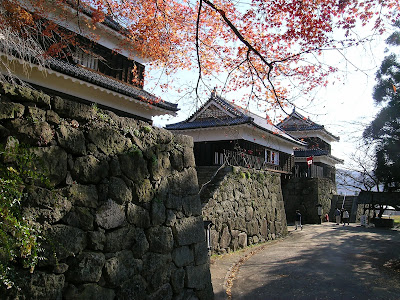my hometown -
I have something to say
to apricot and willow
furusato ya | ume ni yanagi ni | hanashi ari
ふるさとや梅に柳にはなしあり
Shirao

[Ueda Castle]
The hometown in this haiku is the small but attractive castle town of Ueda, located between Karuizawa and Nagano. The town was propelled to fame in the late 16th c. when a much smaller army of defenders under Sanada Yukimura twice repelled the superior forces of national unificator Tokugawa Ieyasu ( as celebrated in the historical novel Sanada Taiheiki by the modern author Ikenami Shotaro). Much earlier, during the Nara period, Ueda already was the capital of Shinano province; however, in the Heian period the provincial capital was shifted to Matsumoto. During the Sengoku period, the area became the center of the powerful Sanada clan, and in the ensuing Edo period Ueda functioned as a castle town and headquarters of the Ueda domain.
Today, Ueda is a regional commercial center with both agriculture and light industry. The main crops include rice, apples, grapes and cabbage. The traditional industry of Ueda was sericulture, but the city now produces automobile components and electronics. For visitors, the most interesting part of Ueda is Bessho, an ancient spa,
which besides the healing waters boasts several great temples. Anrakuji
and Daihoji both have "national treasure"-status pagodas. Nagano prefecture's main river, the river Chikuma, flows through Ueda.
The haiku poet Kaya Shirao (1738-91) was not actually born in Ueda, but in the Edo mansion of the ruling clan of Ueda. He spent his life as a celebrated haiku master in Edo, trying to revive the style of Basho. But he often visited Ueda and also had many pupils in this area. In fact, his relation to Ueda was deepened because his brother and sister moved there, the latter in marriage. Shirao's first Ueda visit took place in 1767 and that is when he wrote the present haiku. It aptly gives voice to the feeling of familiarity one feels in one's hometown: nobody one meets is like a stranger, even apricot (ume) trees and willows are like old friends one could immediately start a conversation with.
Another haiku by Shirao was written in 1774 at Usui Pass, east of Ueda,
presumably when Shirao was again traveling between Edo and Ueda.
at cloudy Usui Pass
I always hear
the mountain cuckoo
hinakumori | kanarazu yo yama | hototogisu
鄙曇必与山子規「ひなぐもりかならずよやまほととぎす」
Usui Pass is not literally mentioned, but according to a commentary "hinakumori", a combination of "rustic" and "cloudy" always is used to refer to Usui Pass (presumably by the inhabitants of Ueda, as they were returning via this pass to their "rustic" hometown). Usui is the mountain pass that lies between Nagano and Gunma prefectures; it was the major route between Edo and Nagano.
The "hototogisu" is the "lesser cuckoo" but it should be noted that it has more positive connotations than its European relatives. The bird has relatively large wings and a long tail, a gray back and a white belly with black stripes. The bad habit it has in common with the Western cuckoo is that it, too, is a parasitic breeder. But the Japanese lesser cuckoo has a gentle call and is one of the best loved Oriental song birds. As it arrives around May in Japan, it is considered the harbinger of warmer weather.
From the time of the first poetry collection, the Manyoshu (8th
century), this small bird has inspired many poets. In haiku, it figures
as a season word for 'early summer.' As the call of the hototogisu is
rather sad, it was also interpreted as expressing the melancholy longing
of the soul of a dead person. And as it was believed to sing until it
coughed out blood, the modern haiku poet Masaoka Shiki who suffered from
tuberculosis took "hototogisu" in the pronunciation "shiki" as his
pen name...
In the above haiku, Shirao is traveling in the mountains where he hears the song of this bird. It is cloudy, so he cannot see the bird, but he can hear its clear song, as if welcoming him home.

[Statue of Sanada Yukimura, Ueno (Nagano)]
The following haiku is generally considered as Shirao's masterpiece.
a sense of loneliness
when at dusk the lamps are lit
and blossoms keep falling
hito koishi | hitoboshi koro wo | sakura chiru
人恋し火とぼしころを桜ちるThe poet is visiting Mr Yoshino in Nara prefecture, far from home, in the blossom season when Yoshino was (and is) a popular destination - the first cherry trees were apparently planted more than 1300 years ago, and today the mountain is covered by thousands of cherry trees.
It is early evening at the end of the blossom season. While the petals keep floating down, the first lamps are being lit, reminding the poet of his far-away home. Travelers will remember the melancholy feeling sometimes evoked by that particular time of day.
The first haiku stone stands in Ueda City at the spot where the house of
Shirao's brother Yoshishige was located (1-7 Chuo-Nishi); the second
one stands in Ueda Castle Park and the third one at the entrance to the
park. The second stone was set up in 1919 by a haiku scholar, and is
surprisingly completely written in Chinese characters; the other two
date from 1990 when the city commemorated the 200th anniversary of the
death of Shirao.
Ueda is easily reached by 90 min Shinkansen from Tokyo. The Castle Park is a 15-min walk from the station.
Information about Shirao and his haiku stones in Ueda was thankfully gleaned from the Kaya Shirao Homepage by "The Preservation Party in Memory of Shirao Kaya," where you will
find more information about the poet, as well as translations of some of his haiku.
[The photos in this post are my own]


